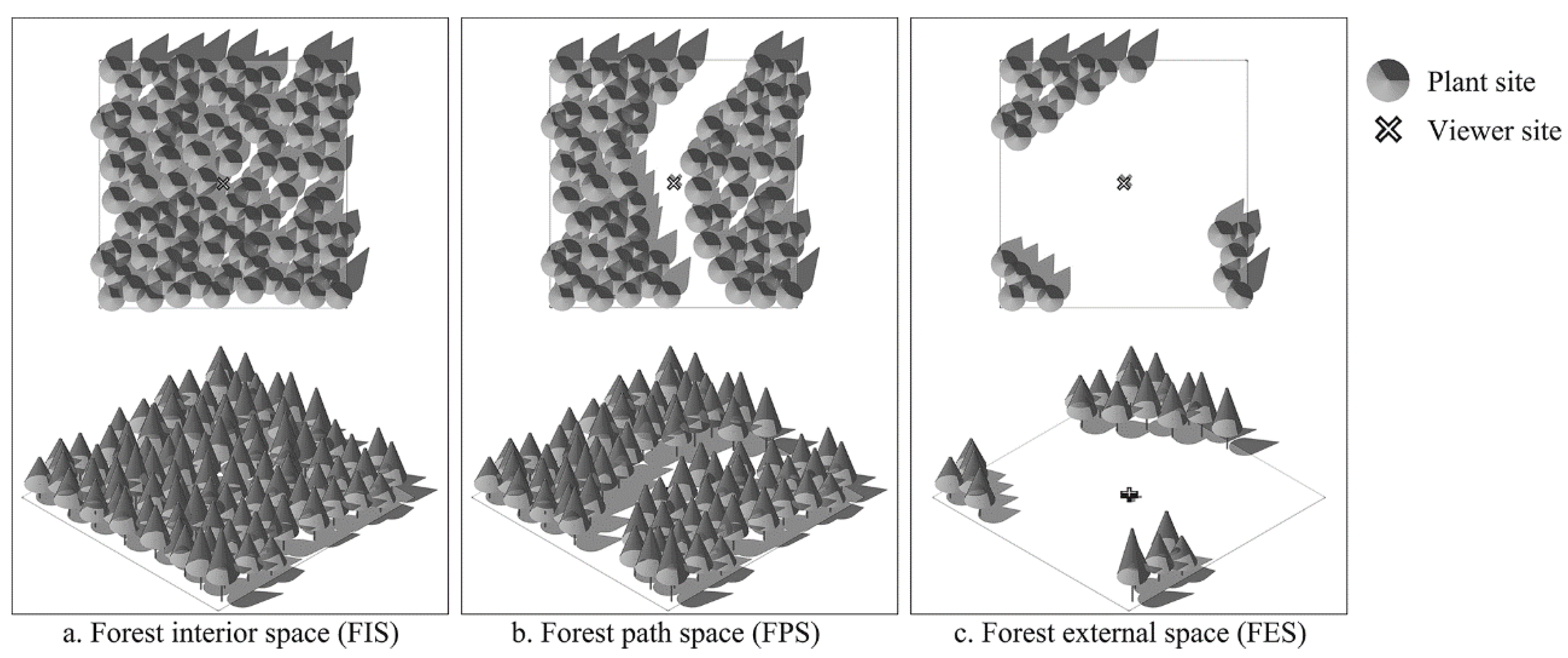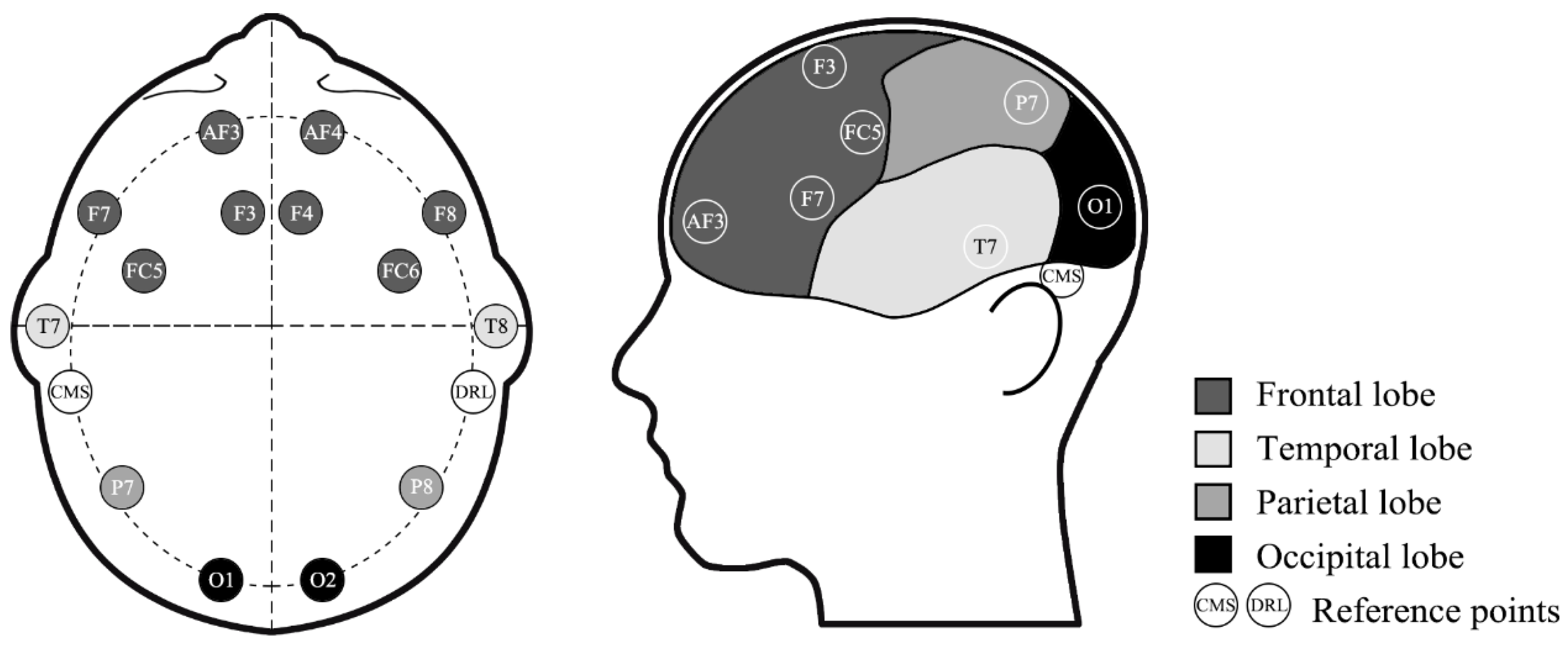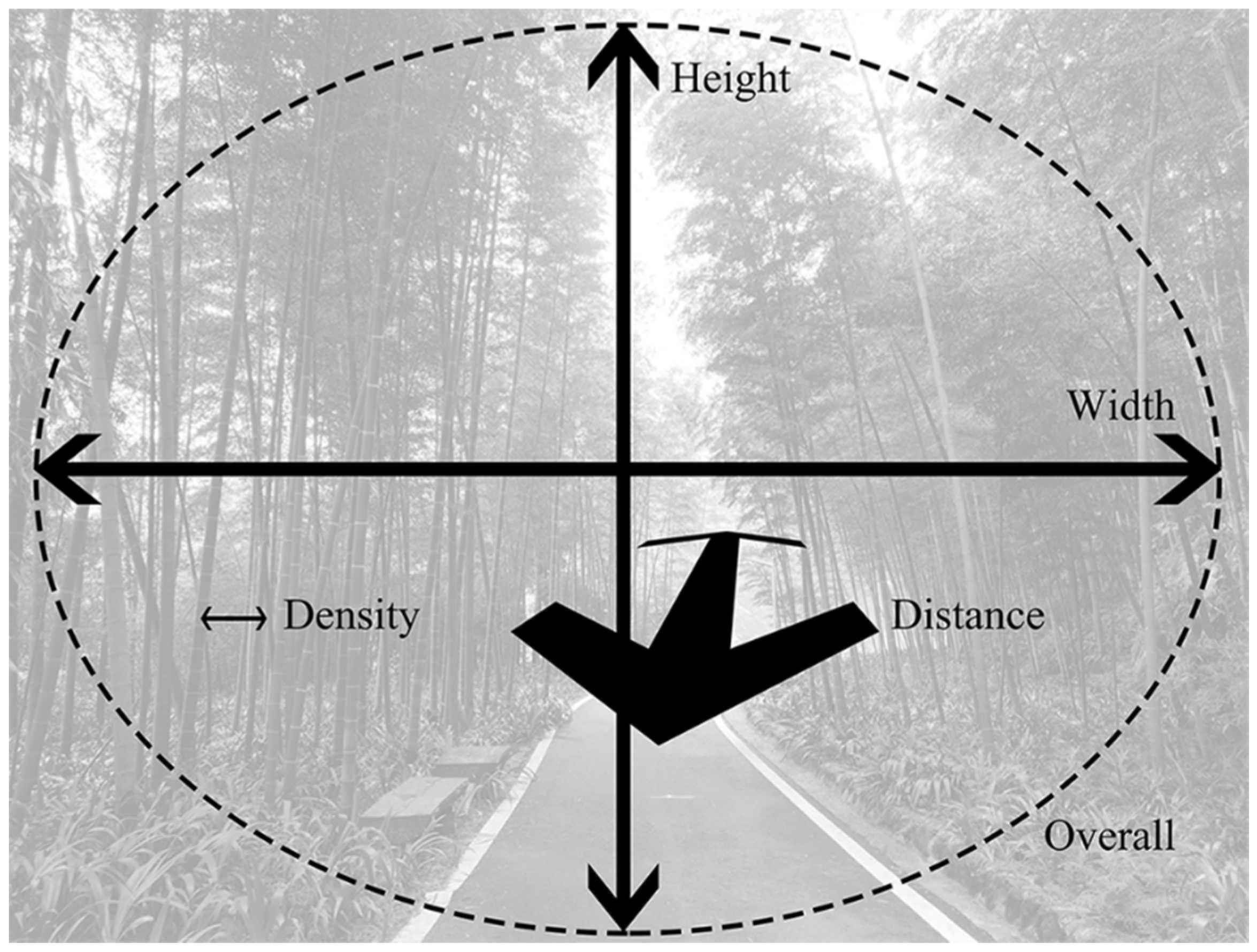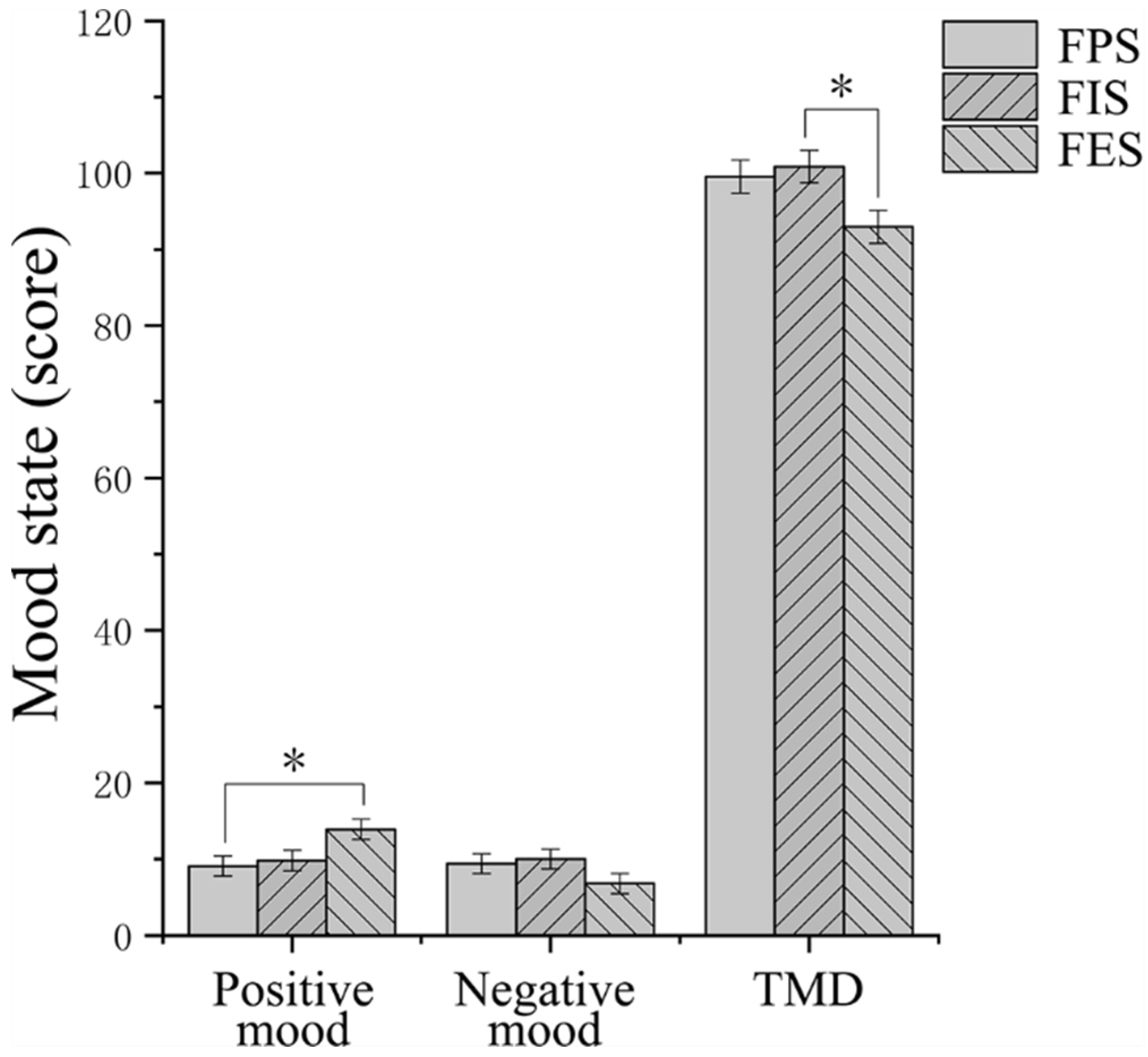Effects of Different Bamboo Forest Spaces on Psychophysiological Stress and Spatial Scale Evaluation
Abstract
1. Introduction
1.1. Forest Health Benefits and the Effect of Forest on Physiological and Psychological Stress
1.2. Spatial Scale Effects and Space Types of Pure Forest
1.3. Aims and Hypotheses
2. Materials and Methods
2.1. Stimuli Selection
2.2. Participants
2.3. Measurements
2.3.1. Physiological Stress
2.3.2. Psychological Stress
2.3.3. Spatial Scale Score
2.4. Procedure
2.5. Statistical Analysis
3. Results
3.1. Effects of Bamboo Forest Space on Physiological Stress
3.2. Effects of Bamboo Forest Space on Psychological Stress
3.3. Spatial Scale Scores for Bamboo Forest Spaces
4. Discussion
4.1. Does Bamboo Forest Space Affect Physiological and Psychological Stress?
4.2. Are There Differences in the Spatial Scale Evaluation of Bamboo Forest Spaces?
4.3. Limitations and Future Research
4.4. Application
5. Conclusions
Author Contributions
Funding
Acknowledgments
Conflicts of Interest
Appendix A
| EEG (β/α Index) | Sum of Squares | df | Mean Square | F | Sig. | Partial η² | Pairwise Comparisons |
|---|---|---|---|---|---|---|---|
| F3 channel | |||||||
| Pre-test | 0.129 | 1 | 0.129 | 0.061 | 0.805 | 0.001 | |
| Group | 11.774 | 2 | 5.887 | 2.795 | 0.070 | 0.091 | |
| Error | 117.938 | 56 | 2.106 | ||||
| R² = 0.096 (Adj R² = 0.047) | |||||||
| F4 channel | |||||||
| Pre-test | 0.057 | 1 | 0.057 | 0.055 | 0.815 | 0.001 | |
| Group | 5.974 | 2 | 2.987 | 2.885 | 0.064 | 0.093 | |
| Error | 57.980 | 56 | 1.035 | ||||
| R² = 0.094 (Adj R² = 0.046) | |||||||
| T7 channel | |||||||
| Pre-test | 1.208 | 1 | 1.208 | 0.695 | 0.408 | 0.012 | |
| Group | 11.216 | 2 | 5.608 | 3.227 | 0.047 * | 0.103 | FES < FIS |
| Error | 97.335 | 56 | 1.738 | ||||
| R² = 0.141 (Adj R² = 0.095) | |||||||
| T8 channel | |||||||
| Pre-test | 0.963 | 1 | 0.963 | 0.983 | 0.326 | 0.017 | |
| Group | 4.163 | 2 | 2.082 | 2.126 | 0.129 | 0.071 | |
| Error | 54.836 | 56 | 0.979 | ||||
| R² = 0.095 (Adj R² = 0.046) | |||||||
| P7 channel | |||||||
| Pre-test | 11.063 | 1 | 11.063 | 12.114 | 0.001 | 0.178 | |
| Group | 17.945 | 2 | 8.973 | 9.825 | 0.000 ** | 0.260 | FES, FPS < FIS |
| Error | 51.140 | 56 | 0.913 | ||||
| R² = 0.417 (Adj R² = 0.386) | |||||||
| P8 channel | |||||||
| Pre-test | 17.189 | 1 | 17.189 | 16.155 | 0.000 | 0.224 | |
| Group | 5.030 | 2 | 2.515 | 2.364 | 0.103 | 0.078 | |
| Error | 59.584 | 56 | 1.064 | ||||
| R² = 0.360 (Adj R² = 0.326) | |||||||
| O1 channel | |||||||
| Pre-test | 6.419 | 1 | 6.419 | 9.717 | 0.003 | 0.148 | |
| Group | 5.162 | 2 | 2.581 | 3.907 | 0.026 * | 0.122 | FES < FIS |
| Error | 36.994 | 56 | 0.661 | ||||
| R² = 0.293 (Adj R² = 0.255) | |||||||
| O2 channel | |||||||
| Pre-test | 12.248 | 1 | 12.248 | 34.657 | 0.000 | 0.382 | |
| Group | 2.418 | 2 | 1.209 | 3.420 | 0.040 * | 0.109 | FES < FIS |
| Error | 19.791 | 56 | 0.353 | ||||
| R² = 0.494 (Adj R² = 0.466) | |||||||
| Mood State | Sum of Squares | df | Mean Square | F | Sig. | Partial η² | Pairwise Comparisons |
|---|---|---|---|---|---|---|---|
| Positive mood (score) | |||||||
| Pre-test | 495.228 | 1 | 495.228 | 14.540 | 0.000 | 0.206 | |
| Group | 269.449 | 2 | 134.724 | 3.956 | 0.025 * | 0.124 | FES > FPS |
| Error | 1907.322 | 56 | 34.059 | ||||
| R² = 0.306 (Adj R² = 0.269) | |||||||
| Negative mood (score) | |||||||
| Pre-test | 609.634 | 1 | 609.634 | 18.820 | 0.000 | 0.252 | |
| Group | 106.774 | 2 | 53.387 | 1.648 | 0.202 | 0.056 | |
| Error | 1814.016 | 56 | 32.393 | ||||
| R² = 0.256 (Adj R² = 0.216) | |||||||
| TMD (score) | |||||||
| Pre-test | 535.184 | 1 | 535.184 | 5.918 | 0.018 | 0.096 | |
| Group | 680.000 | 2 | 340.000 | 3.760 | 0.029 * | 0.118 | FES < FIS |
| Error | 5064.316 | 56 | 90.434 | ||||
| R² = 0.168 (Adj R² = 0.123) | |||||||
| Spatial scales | N | M | SD | F | Sig. | Tukey’s HSD | |
|---|---|---|---|---|---|---|---|
| Total | FPS | 20 | 12.90 | 2.33734 | 16.718 | 0.000 ** | FES, FPS > FIS |
| FIS | 20 | 9.70 | 2.47301 | ||||
| FES | 20 | 13.40 | 1.69830 | ||||
| Width | FPS | 20 | 2.50 | 0.88852 | 15.005 | 0.000 ** | FES, FPS > FIS |
| FIS | 20 | 1.75 | 0.91047 | ||||
| FES | 20 | 3.20 | 0.69585 | ||||
| Height | FPS | 20 | 2.40 | 0.82078 | 1.585 | 0.214 | |
| FIS | 20 | 1.95 | 1.05006 | ||||
| FES | 20 | 2.40 | 0.88258 | ||||
| Distance | FPS | 20 | 2.75 | 0.85070 | 1.562 | 0.219 | |
| FIS | 20 | 2.30 | 0.86450 | ||||
| FES | 20 | 2.40 | 0.82078 | ||||
| Density | FPS | 20 | 2.45 | 0.82558 | 12.554 | 0.000 ** | FES, FPS > FIS |
| FIS | 20 | 1.35 | 0.74516 | ||||
| FES | 20 | 2.60 | 0.99472 | ||||
| Overall | FPS | 20 | 2.80 | 0.76777 | 2.335 | 0.106 | |
| FIS | 20 | 2.35 | 0.98809 | ||||
| FES | 20 | 2.80 | 0.41039 | ||||
References
- Lin, W.; Chen, Q.; Jiang, M.; Zhang, X.; Liu, Z.; Tao, J.; Wu, L.; Xu, S.; Kang, Y.; Zeng, Q. The effect of green space behaviour and per capita area in small urban green spaces on psychophysiological responses. Landsc. Urban Plan. 2019, 192, 103637. [Google Scholar] [CrossRef]
- Flouri, E.; Midouhas, E.; Joshi, H. The role of urban neighbourhood green space in children’s emotional and behavioural resilience. J. Environ. Psychol. 2014, 40, 179–186. [Google Scholar] [CrossRef]
- Jonker, M.F.; van Lenthe, F.J.; Donkers, B.; Mackenbach, J.P.; Burdorf, A. The effect of urban green on small-area (healthy) life expectancy. J. Epidemiol. Community Health 2014, 68, 999–1002. [Google Scholar] [CrossRef] [PubMed]
- Bergmann, F.; Gregorius, H.R.; Kownatzki, D.; Wehenkel, C. Different diversity measures and genetic traits reveal different speciesgenetic diversity relationships: A case study in forest tree communities. Silvae Genet. 2013, 62, 25–37. [Google Scholar] [CrossRef][Green Version]
- Uddling, J.; Teclaw, R.M.; Kubiske, M.E.; Pregitzer, K.S.; Ellsworth, D.S. Sap flux in pure aspen and mixed aspen-birch forests exposed to elevated concentrations of carbon dioxide and ozone. Tree Physiol. 2008, 28, 1231. [Google Scholar] [CrossRef]
- Gebauer, T.; Horna, V.; Leuschner, C. Canopy transpiration of pure and mixed forest stands with variable abundance of European beech. J. Hydrol. 2012, 442–443, 2–14. [Google Scholar] [CrossRef]
- Chang, C.-Y.; Hammitt, W.E.; Chen, P.-K.; Machnik, L.; Su, W.-C. Psychophysiological responses and restorative values of natural environments in Taiwan. Landsc. Urban Plan. 2008, 85, 79–84. [Google Scholar] [CrossRef]
- Park, B.-J.; Tsunetsugu, Y.; Kasetani, T.; Morikawa, T.; Kagawa, T.; Miyazaki, Y. Physiological effects of forest recreation in a young conifer forest in Hinokage Town, Japan. Silva Fenn. 2015, 43, 291–301. [Google Scholar] [CrossRef]
- Chen, H.-T.; Yu, C.-P.; Lee, H.-Y. The Effects of Forest Bathing on Stress Recovery: Evidence from Middle-Aged Females of Taiwan. Forests 2018, 9, 403. [Google Scholar] [CrossRef]
- Ochiai, H.; Ikei, H.; Song, C.; Kobayashi, M.; Miura, T.; Kagawa, T.; Li, Q.; Kumeda, S.; Imai, M.; Miyazaki, Y. Physiological and Psychological Effects of a Forest Therapy Program on Middle-Aged Females. Int. J. Environ. Res. Public Health 2015, 12, 15222–15232. [Google Scholar] [CrossRef]
- Ohe, Y.; Ikei, H.; Song, C.; Miyazaki, Y. Evaluating the relaxation effects of emerging forest-therapy tourism: A multidisciplinary approach. Tour. Manag. 2017, 62, 322–334. [Google Scholar] [CrossRef]
- Song, C.; Ikei, H.; Miyazaki, Y. Sustained effects of a forest therapy program on the blood pressure of office workers. Urban For. Urban Green. 2017, 27, 246–252. [Google Scholar] [CrossRef]
- Williams, K.J.H.; Cary, J. Landscape Preferences, Ecological Quality, and Biodiversity Protection. Environ. Behav. 2016, 34, 257–274. [Google Scholar] [CrossRef]
- Lee, J.; Park, B.-J.; Tsunetsugu, Y.; Kagawa, T.; Miyazaki, Y. Restorative effects of viewing real forest landscapes, based on a comparison with urban landscapes. Scand. J. For. Res. 2009, 24, 227–234. [Google Scholar] [CrossRef]
- Hassan, A.; Chen, Q.B.; Jiang, T.; Lyu, B.Y.; Li, N.; Li, S.; Shangguan, Z.Y.; Li, Y.T.; Jun, Z.L.; Luo, Q.; et al. Psychophysiological Effects of Bamboo Plants on Adults. Biomed. Environ. Sci. 2017, 30, 846–850. [Google Scholar] [CrossRef]
- Chiang, Y.-C.; Li, D.; Jane, H.-A. Wild or tended nature? The effects of landscape location and vegetation density on physiological and psychological responses. Landsc. Urban Plan. 2017, 167, 72–83. [Google Scholar] [CrossRef]
- Beili, Z. Brief introduction of POMS scale and its model for China. J. Tianjin Inst. Phys. Educ. 1995, 10, 35–37. [Google Scholar]
- Kacha, L.; Matsumoto, N.; Mansouri, A. Electrophysiological Evaluation of Perceived Complexity in Streetscapes. J. Asian Archit. Build. Eng. 2015, 14, 585–592. [Google Scholar] [CrossRef]
- Neale, C.; Aspinall, P.; Roe, J.; Tilley, S.; Mavros, P.; Cinderby, S.; Coyne, R.; Thin, N.; Bennett, G.; Thompson, C.W. The Aging Urban Brain: Analyzing Outdoor Physical Activity Using the Emotiv Affectiv Suite in Older People. J. Urban Health 2017, 94, 869–880. [Google Scholar] [CrossRef]
- Zou, B.; Liu, Y.; Guo, M.; Wang, Y. EEG-Based Assessment of Stereoscopic 3D Visual Fatigue Caused by Vergence-Accommodation Conflict. J. Disp. Technol. 2015, 11, 1076–1083. [Google Scholar] [CrossRef]
- Hsu, B.W.; Wang, M.J. Evaluating the effectiveness of using electroencephalogram power indices to measure visual fatigue. Percept. Mot. Ski. 2013, 116, 235–252. [Google Scholar] [CrossRef] [PubMed]
- Kim, J.-Y.; Kim, J.-T.; Kim, W. Psycho-physiological responses of drivers to road section types and elapsed driving time on a freeway. Can. J. Civ. Eng. 2015, 42, 881–888. [Google Scholar] [CrossRef]
- Watts, G.; Khan, A.; Pheasant, R. Influence of soundscape and interior design on anxiety and perceived tranquillity of patients in a healthcare setting. Appl. Acoust. 2016, 104, 135–141. [Google Scholar] [CrossRef]
- Krzywicka, P.; Byrka, K. Restorative Qualities of and Preference for Natural and Urban Soundscapes. Front. Psychol. 2017, 8, 1705. [Google Scholar] [CrossRef] [PubMed]
- Gehl, J. Life Between Buildings: Using Public Space; Island Press: Washington, DC, USA, 2011; p. 216. [Google Scholar]
- Hall, E.T. The silent language; Anchor Books: New York, NY, USA, 1973; p. 217. [Google Scholar]
- Lawson, B.R. The Language of Space. Nature 2007, 252, 93. [Google Scholar] [CrossRef]
- Suh, Y.A.; Yim, M.-S. ‘‘High risk non-initiating insider” identification based on EEG analysis for enhancing nuclear security. Ann. Nucl. Energy 2018, 113, 308–318. [Google Scholar] [CrossRef]
- Cahn, D.A.; Salmon, D.P.; Butters, N.; Wiederholt, W.C.; Corey-Bloom, J.; Edelstein, S.L.; Barrett-Connor, E. Detection of dementia of the Alzheimer type in a population-based sample: Neuropsychological test performance. J. Int. Neuropsychol. Soc. 1995, 1, 252–260. [Google Scholar] [CrossRef]
- Gotts, Z.M.; Ellis, J.G.; Deary, V.; Barclay, N.; Newton, J.L. The association between daytime napping and cognitive functioning in chronic fatigue syndrome. PLoS ONE 2015, 10, e0117136. [Google Scholar] [CrossRef]
- Daniel, T.C.; Boster, R.S. Measuring Landscape Esthetics: The Scenic Beauty Estimation Method; Res. Pap. RM-RP-167; U.S. Department of Agriculture, Forest Service, Rocky Mountain Range and Experiment Station: Fort Collins, CO, USA, 1976; p. 66.
- Fredrickson, B.L.; Levenson, R.W. Positive Emotions Speed Recovery from the Cardiovascular sequelae of negative emotions. Cogn. Emot. 1998, 12, 191–220. [Google Scholar] [CrossRef]
- Purcell, A.T.; Lambb, R.J. Preference and naturalness: An ecological approach. Landsc. Urban Plan. 1998, 42, 57–66. [Google Scholar] [CrossRef]
- Jiang, B.; Larsen, L.; Deal, B.; Sullivan, W.C. A dose–response curve describing the relationship between tree cover density and landscape preference. Landsc. Urban Plan. 2015, 139, 16–25. [Google Scholar] [CrossRef]
- Hartig, T.; Evans, G.W.; Jamner, L.D.; Davis, D.S.; Gärling, T. Tracking restoration in natural and urban field settings. J. Environ. Psychol. 2003, 23, 109–123. [Google Scholar] [CrossRef]
- Song, C.; Joung, D.; Ikei, H.; Igarashi, M.; Aga, M.; Park, B.-J.; Miwa, M.; Takagaki, M.; Miyazaki, Y. Physiological and psychological effects of walking on young males in urban parks in winter. J. Physiol. Anthropol. 2013, 32, 18. [Google Scholar] [CrossRef] [PubMed]
- Taylor, A.F.; Kuo, F.E. Children with attention deficits concentrate better after walk in the park. J. Atten. Disord. 2009, 12, 402–409. [Google Scholar] [CrossRef]
- Jiang, B.; Chang, C.-Y.; Sullivan, W.C. A dose of nature: Tree cover, stress reduction, and gender differences. Landsc. Urban Plan. 2014, 132, 26–36. [Google Scholar] [CrossRef]
- Kaplan, R.; Kaplan, S.; Ryan, R.L. With People in Mind; Island Press: Washington, DC, USA, 1998. [Google Scholar]
- Kaplan, R. The Nature of the View from Home: Psychological Benefits. Environ. Behav. 2016, 33, 507–542. [Google Scholar] [CrossRef]








© 2020 by the authors. Licensee MDPI, Basel, Switzerland. This article is an open access article distributed under the terms and conditions of the Creative Commons Attribution (CC BY) license (http://creativecommons.org/licenses/by/4.0/).
Share and Cite
Lin, W.; Chen, Q.; Zhang, X.; Tao, J.; Liu, Z.; Lyu, B.; Li, N.; Li, D.; Zeng, C. Effects of Different Bamboo Forest Spaces on Psychophysiological Stress and Spatial Scale Evaluation. Forests 2020, 11, 616. https://doi.org/10.3390/f11060616
Lin W, Chen Q, Zhang X, Tao J, Liu Z, Lyu B, Li N, Li D, Zeng C. Effects of Different Bamboo Forest Spaces on Psychophysiological Stress and Spatial Scale Evaluation. Forests. 2020; 11(6):616. https://doi.org/10.3390/f11060616
Chicago/Turabian StyleLin, Wei, Qibing Chen, Xiaoxia Zhang, Jinying Tao, Zongfang Liu, Bingyang Lyu, Nian Li, Di Li, and Chengcheng Zeng. 2020. "Effects of Different Bamboo Forest Spaces on Psychophysiological Stress and Spatial Scale Evaluation" Forests 11, no. 6: 616. https://doi.org/10.3390/f11060616
APA StyleLin, W., Chen, Q., Zhang, X., Tao, J., Liu, Z., Lyu, B., Li, N., Li, D., & Zeng, C. (2020). Effects of Different Bamboo Forest Spaces on Psychophysiological Stress and Spatial Scale Evaluation. Forests, 11(6), 616. https://doi.org/10.3390/f11060616





